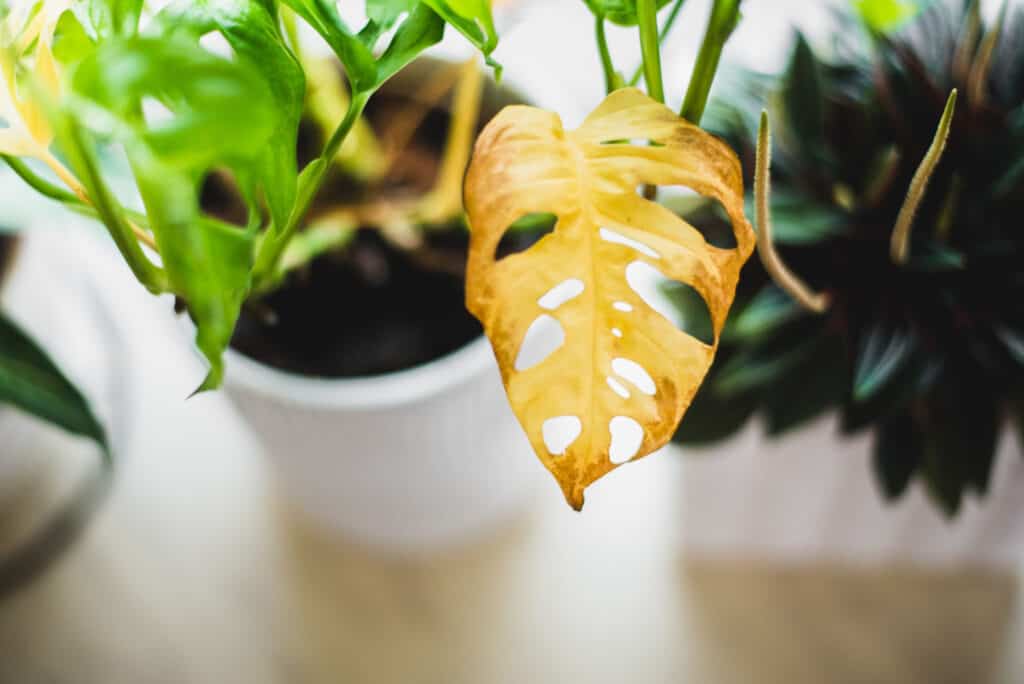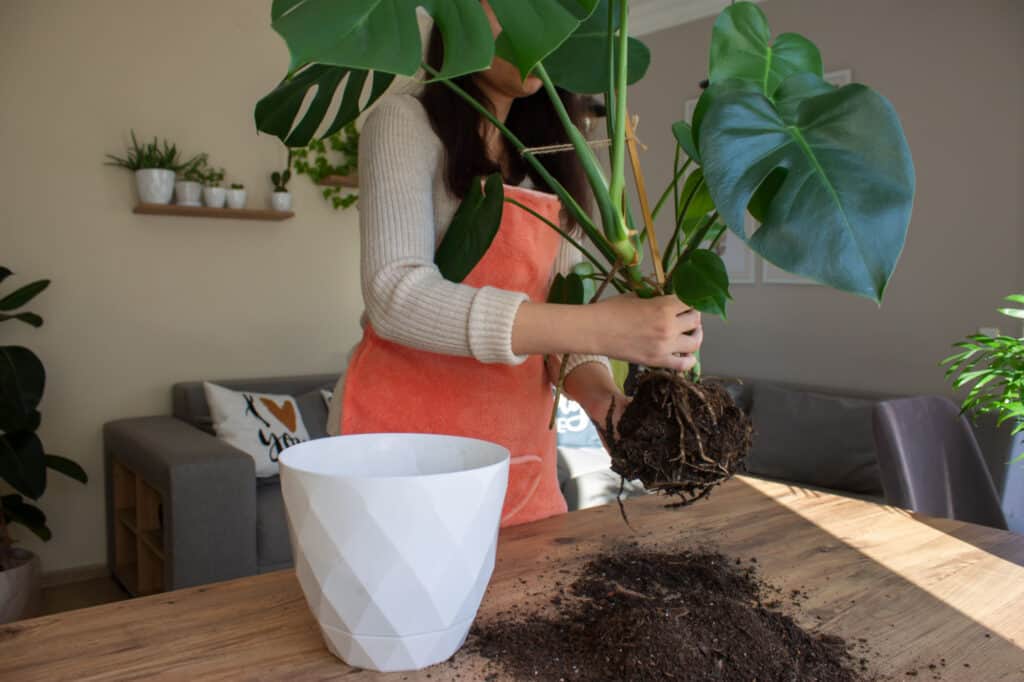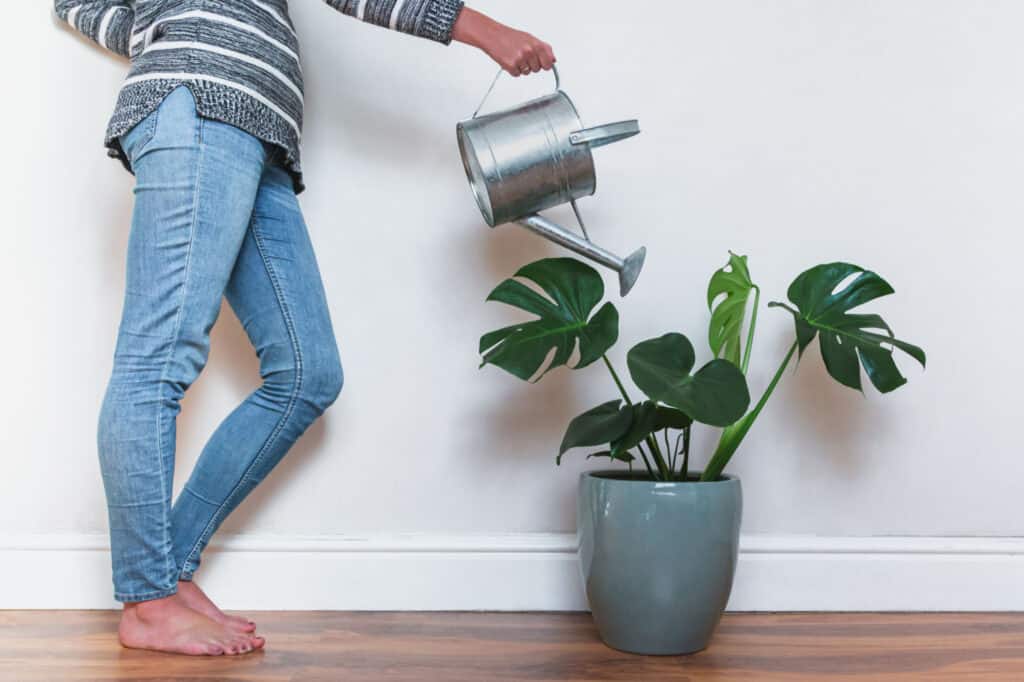If you’ve noticed brown spots on monstera leaves, you may be wondering how to fix them. This isn’t the only problem that commonly plagues monstera houseplants, given the fact that this tropical showstopper needs warm temperatures and certain amounts of water. How can you know what your monstera needs, and how can you best troubleshoot your plant so that it continues to grow?
In this article, we will address why your monsteras leaves might have brown spots, as well as many other common problems. We will go over some easy ways to troubleshoot your monstera plant so that it continues to thrive. From drooping leaves to common pests that plague indoor monstera plants, here’s everything you need to know about keeping your monstera happy!
Brown Spots on Monstera Leaves: What Does This Mean?

Usually, a monstera will produce yellow or brown leaves as a result of overwatering.
©Jus_Ol/Shutterstock.com
One of the most common issues that happen to monstera plants is spotting or discoloration of the leaves. If you’ve noticed brown spots on the leaves of your monstera plant, this is a common issue with a few different solutions. However, troubleshooting and sleuthing out what exactly is happening to your plant is the hardest part of the process!
Brown spots on monstera leaves could mean a number of things, but the primary culprit is often overwatering. Your monstera houseplant can easily suffer from too much moisture, particularly if it has been planted in improperly draining soil or consistently watered too much. However, this isn’t the only cause for discoloration on the foliage of a monstera.
Troubleshooting Your Monstera: Tips and Tricks

You won’t need to repot your monstera every single year unless it grows quickly.
©EmreCinar/Shutterstock.com
If you’ve noticed a significant lack of growth or see different problems happening with your monstera plant, what can you do to help it? Here’s a list of some common troubles that occur in monstera houseplants and what you can do about it.
Black Leaves
If your monstera is producing black spots or blackened leaves, this is a sign of a number of different problems. For example, unexpected cold temperatures can cause your monstera’s leaves to turn black. Overwatering can also lead to black leaves or black spots on your monstera’s foliage and root rot may follow. If your plant is exposed to too much direct sunlight, the leaves will burn and turn black as well. These discolorations may also be a sign of certain fungal infections, so keep this in mind if the problem persists and remove any damaged leaves promptly.
Yellow Leaves
Having yellow leaves is a less extreme problem compared to black leaves on your monstera. The most common cause of yellow leaves is a lack of sunlight or perhaps your monstera is receiving too much water. Make sure that you don’t place your monstera in a location that is too sunny, but you may also consider adjusting the watering schedule for your houseplant as well.
Drooping Plant
If your monstera seems unhappy, the most common cause for drooping leaves or stems is underwatering. Your monstera loves humidity and water, so striking a proper balance is important. You may need to adjust the pot that your monstera is in, or perhaps just make sure to give it a bit more water this week!

If your monstera appears unhappy, it may need more or less water.
©Chodimeafotime/Shutterstock.com
Wrinkled or Curling Leaves
Similarly to a drooping monstera plant, having leaves that are curled or wrinkling also points to the fact that your plant needs more water. Whether it’s the soil you’re using or the pot that your monstera is in, you may want to consider adjusting its container and investigating the health of your plant’s roots. Hopefully, a simple adjustment of your watering schedule will keep your monstera happy!
Monstera Pests and Bugs
All houseplants risk certain infections or infestations from common pests and bugs, your monstera included. Thankfully, most pests that might attack your monstera are fairly easy to spot and treats. Purchasing a simple insecticide and utilizing it according to the instructions of the product should help clear out any bugs.
Leaves Without Holes or Splits
The monstera is also known as a split-leaf philodendron or Swiss cheese plant for a reason. However, if you notice that your beloved monstera plant isn’t developing leaves with holes or splits in them, you may be wondering what’s wrong. The most common reason why your monstera likely isn’t developing holes is simply that it isn’t very old. Another reason could be that your monstera isn’t receiving enough light, but it is more likely that your monstera is young. These plants develop their trademark holes as they age, so simply give it time!
Keep Your Monstera Happy!

The monstera adansonii is the second most popular monstera variety.
©Isabella Wand/Shutterstock.com
Hopefully, these helpful tips and tricks will keep your monstera happy for the rest of its life. Always be aware of the amount of water that you are giving your monstera, particularly based on the seasons and humidity in your home. If problems persist, know that most of them are reversible for this hardy and iconic houseplant!
What are the Health Benefits of the Monstera Plant?

If you keep your monstera plant healthy it will provide you with many healthy benefits.
©Francois Louw/Shutterstock.com
We’ve been hearing that houseplants provide many health benefits and enhance our indoor environment with more than just their beauty. Monstera are usually listed as one of the best! How do they make our lives better?
- They purify the air that you breathe with their large leaves that absorb toxins.
- The lush green leaves of the plant can reduce stress levels in the same way that forest bathing refreshes your spirit.
- Monstera lowers the overall humidity levels by absorbing it into their leaves – reducing the possibility of mold and mildew forming in your home.
- Because they grow so big – they absorb sound for a more peaceful environment with less echoing.
- These stunning plants add beauty to your home and are used in Feng Shui.
- They are easy to propagate for sharing with friends!
The photo featured at the top of this post is © Jones M/Shutterstock.com
Sources
- The adaptive function of leaf fenestrations in Monstera spp.(Araceae): a look at water, wind, and herbivory., Available here: https://digital.lib.usf.edu/content/SF/S0/00/14/22/00001/M39-00253-Lubenow_Cassie_Leaf_fenestration_in_Monstera_spp_CIEE_Spring_2011.pdf
Thank you for reading! Have some feedback for us? Contact the AZ Animals editorial team.






